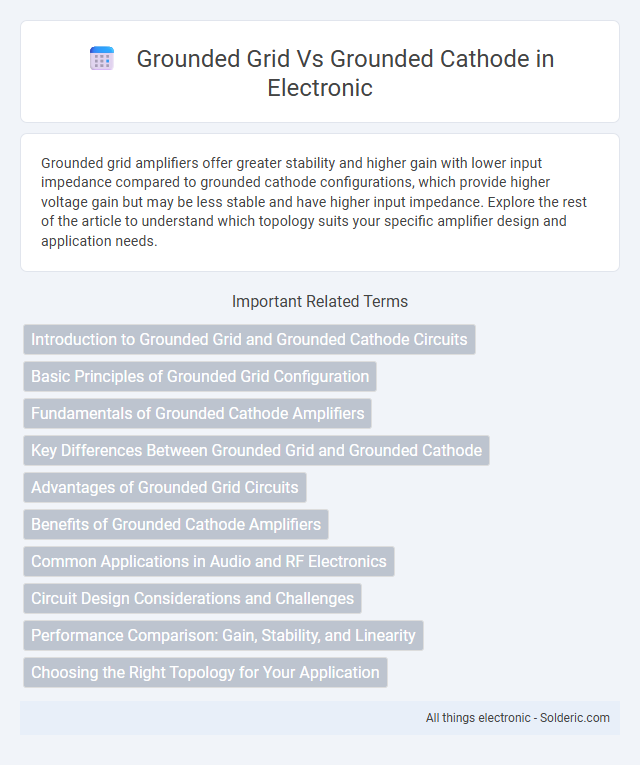Grounded grid amplifiers offer greater stability and higher gain with lower input impedance compared to grounded cathode configurations, which provide higher voltage gain but may be less stable and have higher input impedance. Explore the rest of the article to understand which topology suits your specific amplifier design and application needs.
Comparison Table
| Feature | Grounded Grid | Grounded Cathode |
|---|---|---|
| Configuration | Grid connected to ground; cathode and anode signals vary | Cathode connected to ground; grid and anode signals vary |
| Input Impedance | Low input impedance | High input impedance |
| Voltage Gain | Moderate voltage gain | High voltage gain |
| Phase Inversion | Yes, output signal inverted (180deg phase shift) | Yes, output signal inverted (180deg phase shift) |
| Common Applications | RF amplification, high-frequency tubes, oscillator circuits | Audio amplification, intermediate frequency (IF) amplification |
| Advantages | Good stability, better frequency response at high frequencies | High gain, simple biasing |
| Disadvantages | Lower input impedance limits signal source options | Lower frequency response, potential stability issues |
Introduction to Grounded Grid and Grounded Cathode Circuits
Grounded grid and grounded cathode circuits represent two fundamental amplifier configurations in vacuum tube electronics, each offering unique performance characteristics. Grounded grid circuits, commonly used for high-frequency applications, feature the grid connected directly to the ground, enhancing stability and bandwidth while reducing input impedance. Grounded cathode circuits, often chosen for audio amplification, have the cathode at ground potential, providing higher voltage gain and simpler design, which makes them suitable for a broad range of signal amplification tasks.
Basic Principles of Grounded Grid Configuration
The grounded grid configuration features the grid electrode connected directly to ground potential, stabilizing the input signal and minimizing feedback for high-frequency amplification. In this setup, the cathode serves as the input while the anode provides the amplified output, enhancing gain and linearity in RF circuits. You benefit from improved stability and reduced distortion compared to the grounded cathode arrangement, making grounded grid ideal for high-frequency, low-distortion applications.
Fundamentals of Grounded Cathode Amplifiers
Grounded cathode amplifiers use a cathode directly connected to ground to provide voltage gain by controlling the plate current through the grid voltage. This configuration offers high voltage amplification and moderate input impedance, making it ideal for voltage amplification stages in audio and radio frequency circuits. Your understanding of grounded cathode fundamentals will enhance circuit design choices where signal gain and stability are critical.
Key Differences Between Grounded Grid and Grounded Cathode
The key differences between grounded grid and grounded cathode amplifiers lie in their circuit topology and signal handling. Grounded grid amplifiers offer low input impedance and high gain stability, making them ideal for high-frequency and RF applications, whereas grounded cathode amplifiers provide higher input impedance and better voltage gain suited for audio and low-frequency use. Your choice depends on the specific requirements of impedance matching, frequency range, and gain characteristics in the application.
Advantages of Grounded Grid Circuits
Grounded grid circuits offer superior stability and high-frequency performance compared to grounded cathode configurations, making them ideal for RF amplification and transmitters. They provide low input capacitance and excellent isolation between input and output, reducing unwanted feedback and oscillations. The grounded grid design also enhances linearity and power handling efficiency, benefiting high-power, high-frequency applications.
Benefits of Grounded Cathode Amplifiers
Grounded cathode amplifiers offer higher voltage gain and greater signal amplification compared to grounded grid designs, making them ideal for applications requiring strong output signals. Their simplicity in biasing and stable operation under various load conditions provide improved efficiency and reliability in audio and RF amplification. You benefit from enhanced linearity and better distortion characteristics, resulting in clearer and more accurate signal reproduction.
Common Applications in Audio and RF Electronics
Grounded grid amplifiers are widely used in high-frequency RF applications due to their stability and low input impedance, making them ideal for radio transmitters and RF power amplifiers. Grounded cathode configurations dominate audio amplifier circuits, offering high voltage gain and linearity suitable for guitar amplifiers and hi-fi audio systems. Your choice between these topologies hinges on the specific frequency range and application demands in audio or RF electronics.
Circuit Design Considerations and Challenges
Grounded grid amplifiers offer improved stability and reduced input capacitance, making them suitable for high-frequency circuit designs, but require careful impedance matching and isolation to prevent feedback issues. Grounded cathode configurations provide higher voltage gain and simpler biasing but face challenges with Miller effect capacitance, necessitating compensation techniques to maintain bandwidth and linearity. Circuit designers must balance gain, frequency response, and stability while addressing challenges such as parasitic oscillations and power dissipation unique to each topology.
Performance Comparison: Gain, Stability, and Linearity
Grounded grid amplifiers offer superior high-frequency stability and a wider bandwidth compared to grounded cathode designs, making them ideal for RF applications requiring low feedback and minimal distortion. Grounded cathode configurations typically provide higher voltage gain but can suffer from reduced linearity and potential instability at higher frequencies due to increased Miller effect. Your choice between the two should balance the need for gain versus stability and linearity based on your specific circuit requirements.
Choosing the Right Topology for Your Application
Selecting the appropriate topology between grounded grid and grounded cathode amplifiers depends on the application's frequency range, gain, and stability requirements. Grounded grid amplifiers offer superior stability and broader bandwidth, making them ideal for high-frequency RF applications, while grounded cathode configurations provide higher voltage gain and are preferred in audio and low-frequency circuits. Evaluating factors such as input/output impedance, amplification needs, and distortion levels is crucial to ensure optimal performance and reliability in the intended use case.
Grounded grid vs Grounded cathode Infographic

 solderic.com
solderic.com